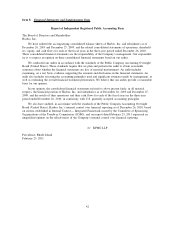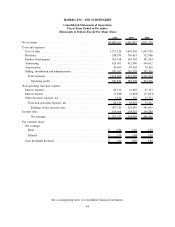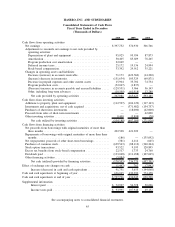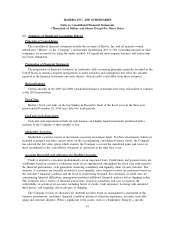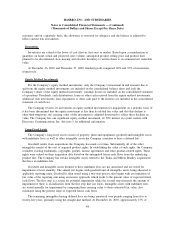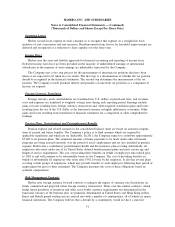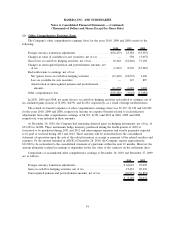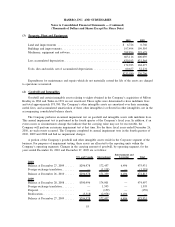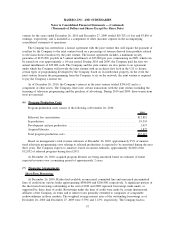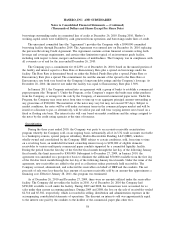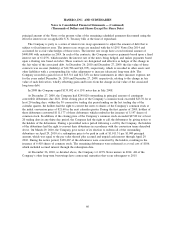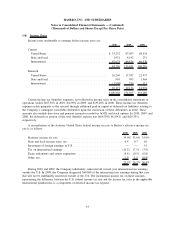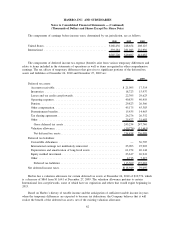Hasbro 2010 Annual Report Download - page 62
Download and view the complete annual report
Please find page 62 of the 2010 Hasbro annual report below. You can navigate through the pages in the report by either clicking on the pages listed below, or by using the keyword search tool below to find specific information within the annual report.
adverse effect on the financial condition of the Company. Hasbro does not enter into derivative financial
instruments for speculative purposes.
At the inception of the contracts, Hasbro designates its derivatives as either cash flow or fair value
hedges. The Company formally documents all relationships between hedging instruments and hedged items as
well as its risk management objectives and strategies for undertaking various hedge transactions. All hedges
designated as cash flow hedges are linked to forecasted transactions and the Company assesses, both at the
inception of the hedge and on an on-going basis, the effectiveness of the derivatives used in hedging
transactions in offsetting changes in the cash flows of the forecasted transaction. The ineffective portion of a
hedging derivative, if any, is immediately recognized in the consolidated statements of operations.
The Company records all derivatives, such as foreign currency exchange contracts, on the balance sheet
at fair value. Changes in the derivative fair values that are designated effective and qualify as cash flow hedges
are deferred and recorded as a component of AOCE until the hedged transactions occur and are then
recognized in the consolidated statements of operations. The Company’s foreign currency contracts hedging
anticipated cash flows are designated as cash flow hedges. When it is determined that a derivative is not
highly effective as a hedge, the Company discontinues hedge accounting prospectively. Any gain or loss
deferred through that date remains in AOCE until the forecasted transaction occurs, at which time it is
reclassified to the consolidated statements of operations. To the extent the transaction is no longer deemed
probable of occurring, hedge accounting treatment is discontinued and amounts deferred would be reclassified
to the consolidated statements of operations. In the event hedge accounting requirements are not met, gains
and losses on such instruments are included currently in the consolidated statements of operations. The
Company uses derivatives to economically hedge intercompany loans denominated in foreign currencies. Due
to the short-term nature of the derivative contracts involved, the Company does not use hedge accounting for
these contracts.
The Company also uses interest rate swap agreements to adjust the amount of long-term debt subject to
fixed interest rates. The interest rate swaps are matched with specific fixed rate long-term debt obligations and
are designated as fair value hedges of the change in fair value of the related debt obligations. These
agreements are recorded at their fair value as an asset or liability. Gains and losses on these contracts are
included in the consolidated statements of operations and are wholly offset by changes in the fair value of the
related long-term debt. These hedges are considered to be perfectly effective under current accounting
guidance. The interest rate swap contracts are with a number of major financial institutions in order to
minimize counterparty credit risk. The Company believes that it is unlikely that any of its counterparties will
be unable to perform under the terms of the contracts.
Accounting for Stock-Based Compensation
The Company has a stock-based employee compensation plan for employees and non-employee members
of the Company’s Board of Directors. Under this plan the Company may grant stock options at or above the
fair market value of the Company’s stock, as well as restricted stock, restricted stock units and contingent
stock performance awards. All awards are measured at fair value at the date of the grant and amortized as
expense on a straight-line basis over the requisite service period of the award. For awards contingent upon
Company performance, the measurement of the expense for these awards is based on the Company’s current
estimate of its performance over the performance period. See note 13 for further discussion.
Net Earnings Per Common Share
Basic net earnings per share is computed by dividing net earnings by the weighted average number of
shares outstanding for the year. Diluted net earnings per share is similar except that the weighted average
number of shares outstanding is increased by dilutive securities, and net earnings are adjusted for certain
52
HASBRO, INC. AND SUBSIDIARIES
Notes to Consolidated Financial Statements — (Continued)
(Thousands of Dollars and Shares Except Per Share Data)


